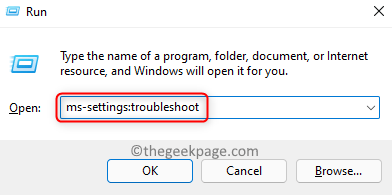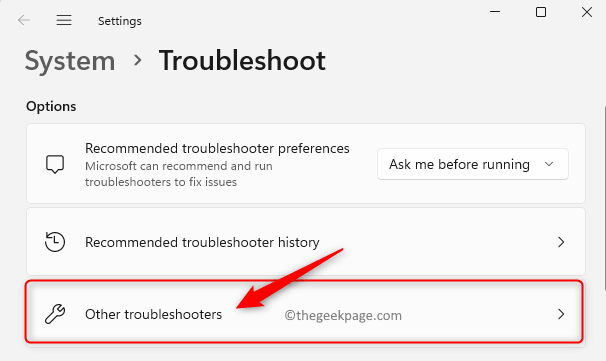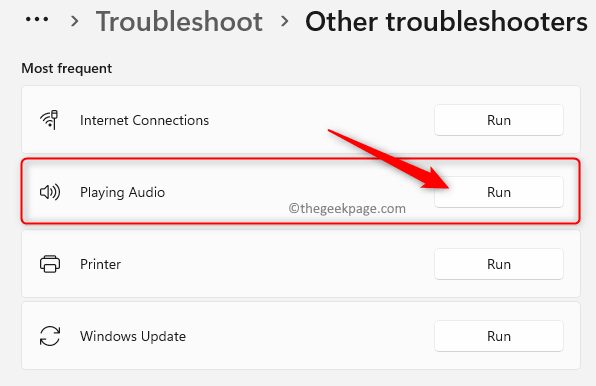Many Windows 11 users have been experiencing a problem with the audio where the system sounds and all the other sounds in the applications are having a low volume. An outdated/incompatible driver, audio enhancements, or the incompatible bit rate format can be some of the possible reasons for this low audio sound on your PC. This problem has mostly been noticed after the system is upgraded to Windows 11 or a Windows update is performed.
Are you annoyed with the low audio issue while listening to any music or playing any games on your Windows 11 PC? Read this article to find some troubleshooting methods that have been helpful to other users in resolving the low volume issue on their Windows 11 PC.
Method 1 – Run the Audio Troubleshooter
Step 1. Open the Run dialog by pressing the Windows and R keys simultaneously on your keyboard.
Step 2. Type ms-settings:troubleshoot and hit Enter to open the Troubleshoot page in the Settings app.
Step 3. On the Troubleshoot page, click on Other troubleshooters.
Step 4. You will see a list of all the other troubleshooters that can be used.
Here, click on the Run button associated with Playing Audio.
Step 5. Wait until the troubleshooter’s initial detection phase is done.
When prompted to choose the device that you want to troubleshoot, select the appropriate audio device from the list and click on Next.
Step 6. Once the scan starts, wait for the analysis of your audio device to complete.
If there is any problem detected, follow the on-screen instructions to use the system-recommended repair.
Once the troubleshooting process is complete, check if the low audio issue is resolved.
Method 2 – Update the Audio Driver
Step 1. Press Windows + X to open the menu associated with the Start button.
Step 2. In this menu, select Device Manager.
Step 3. Expand the Sound, video and game controllers section by clicking on the arrow next to it.
Step 4. Identify the Audio device that is listed here and is giving the low audio issue.
Right-click on this audio device and choose Update driver.
Step 5. In the Update Drivers window, select the option Search automatically for drivers.
Step 6. Once the audio drivers are updated on your PC, check if the problem with the device is fixed.
Step 7. If that does not resolve the issue, then click on Search for updated drivers on Windows Update.
Then, click on Check for updates on the Windows Update page.
Wait for Windows to check for any updates. If there are any found, they will be downloaded and installed.
Step 8. If the problem still exists after a Windows Update, then in the Update Drivers window click on Browse my computer for drivers.
Now, click on Let me pick from a list of available drivers on my computer.
On the next screen, highlight the High Definition Audio Device in the list.
Click on Next.
Once the driver is updated, restart your PC and check if this helped overcome the low audio issue.
Method 3 – Set the Audio Device as Default Device
Step 1. Press Windows + R to open Run.
Type control and hit Enter to open the Control Panel.
Step 2. Make sure that the View by is set to Category. If not, use the dropdown and set it to Category.
Step 3. In the Control Panel, click on Hardware and Sound.
Step 4. On the next screen, click on Sound.
Step 5. In the Playback tab, select the Audio device giving the issue and click on the Set as default button at the bottom.
Then, click on OK.
Step 6. After the audio device has been set as the default device, check if the problem is resolved.
Method 4 – Turn Off Audio Enhancements in Settings
Step 1. Open the Run box by pressing the Windows and R keys simultaneously.
Step 2. Type ms-settings:sound and hit Enter to open the Sound Settings.
Step 3. On this page, in the Output section click on the audio device that is causing the low audio issue.
Step 4. This opens the Properties screen for the selected device.
Here, use the dropdown associated with Audio enhancements and select Off.
Step 5. Close the Settings app.
Check if the issue still persists.
Method 5 – Uninstall the Audio Device Driver
Step 1. Hit the Windows key on your keyboard and type device manager in the Windows search box.
Step 2. Click on Device Manager in the search result.
Step 3. In the Device Manager, click on Sound, video and game controllers to expand it.
Step 4. Right-click on your audio device and choose Uninstall device.
Step 5. In the dialog that pops up for confirmation, check the box next to Attempt to remove the driver for this device.
Then, click on the Uninstall button.
Step 6. Close the Device Manager and reboot your PC.
Step 7. During system restart, Windows will find a missing audio driver and automatically install and enable the generic driver for your audio device.
Check if the problem is resolved.
Method 6 – Change the Bit Rate in Sound Properties
Step 1. Just press and hold Windows and R keys at the same time on your keyboard to open the Run box.
Step 2. Type mmsys.cpl and hit Enter to open the Sound window.
Step 3. In the Playback tab, right-click on your audio device and choose Properties.
Step 4. In the Speaker Properties window, go to the Advanced tab.
Step 5. Here, use the dropdown in the Default Format section and change it to 24-bit, 48000 Hz (Studio Quality).
Step 6. Finally, click on Apply and then on OK.
Step 7. Restart your system and check if the low-volume sound issue is resolved.
Method 7 – Perform a System Restore
Step 1. Press Windows + R to open the Run dialog.
Type rstrui and hit Enter to open the System Restore window.
Step 2. In the System Restore window, click on Next.
Step 3. On the next screen, you will see a list of restore points created on your system.
Here, select a restore point that was created by you manually.
Then, click on Next.
Step 4. In the final screen, check the details of the restore point and click on Finish to start the restore process.
Step 5. Wait for your PC to restart and complete the system restore.
After the system restores your PC will be reverted to the time it was working fine without any issues.
Check if the low audio problem is fixed.
That’s it!
Thanks for reading.
We hope you are now able to watch videos, play games, and listen to music without being annoyed by the low volume. Did you find this article helpful in fixing the low audio issue on your Windows 11 PC? Please comment and let us know your thoughts and the fix that worked for you.



